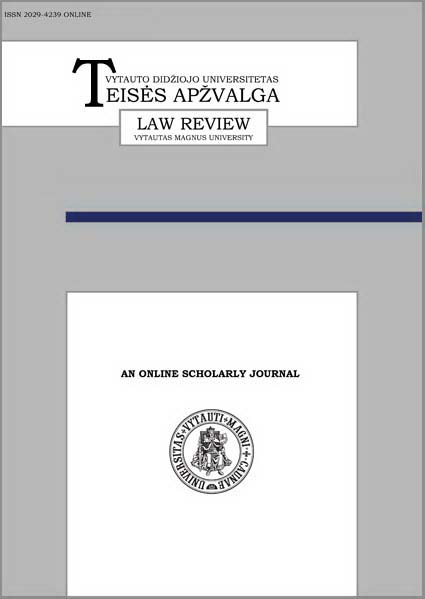Ar galimas analogijos taikymas baudžiamojoje teisėje?
Can the Analogy Be Applied in Criminal Law?
Author(s): Paula JalinskaitėSubject(s): Law, Constitution, Jurisprudence, Criminal Law
Published by: Vytauto Didžiojo Universitetas
Keywords: Gap in Legislation; Interpretation of Legal Norms; Analogy in Criminal Law; Theory of Criminal Law;
Summary/Abstract: The research article analyses whether analogy can be applied in criminal law, as it is a controversial issue, with some researchers arguing that analogy should be prohibited on the basis of the principle of legal certainty, according to which criminal law should be clear and predictable, and others arguing that analogy should be allowed as a necessary instrument for filling in the legislation gaps. Furthermore, global modernization and changing social relations make it a challenge for the legislator to keep up with new developments by amending the law, which leads to gaps in legislation, and thus to the need for interpretation by prosecuting authorities, especially the judiciary, to apply the rules of law in a way which requires interpretation. The analysis of the European Court of Human Rights case law leads to the conclusion that the Court, while underlining the practical need to interpret the provisions of the criminal law and adapt them to changing social relations, has established the prohibition of overly broad interpretations of the criminal law against the accused. The European Court of Human Rights has stated that the requirement of foreseeability of the elements of a criminal offence has been established, however, even if a provision of a criminal law is abstract, this requirement is considered to be fulfilled if a person could have foreseen the criminal nature of the offence either from the wording of the crime or from the court's interpretation of the crime. Interpretation of criminal law by analogy is not violative of the Convention for the Protection of Human Rights and Fundamental Freedoms as well as the Charter of Fundamental Rights of the European Union, provided that it is applied within the bounds of the law and that it does not extend the concept of the offence to such the accused is sentenced on the basis of a rule that is not laid down in any legal act. Furthermore, regulation of the Rome Statute of the International Criminal Court allows the International Criminal Court to interpret legal norms and establish precedents through law and legal analogy, but it is necessary to ensure that the International Criminal Court does not cross the line between the creation of new offences and the interpretation of law. Also, a person may be prosecuted for crimes arising from violations of the general principles of law recognized by civilized nations, i.e. the crime of genocide, crimes against humanity, war crimes and the crime of aggression. Meanwhile, legal analogy may be used to interpret the constituent elements of criminal offences, provided that the principle of foreseeability is guaranteed. Moreover, the analysis of national case law demonstrates that courts apply the legal analogy for the interpretation of the constituent elements of criminal offences, which overlaps with the systemic, linguistic and analogical methods of legal interpretation. The legal analogy does not violate the general and specific principles of criminal law, does not restrict fundamental human rights and freedoms, and can be applied to eliminate gaps in the Criminal Code of the Republic of Lithuania and to interpret norms, provided that the process is carried out without extending the norms beyond the limits envisaged by the legislator, and that its application does not impose any burden on the accused's procedural position and that the latter is not sentenced to a law of a different (non-criminal) legal purpose. Also, national courts apply the analogy of law, as the Criminal Code of the Republic of Lithuania criminalizes violations of the general principles of law recognized by civilized nations, i.e. crimes against humanity and war crimes. The analysis of the legal doctrine, the national, international, and European legal acts, and case law has revealed that the analogy can be applied in criminal law if its application: 1) does not violate general principles of law; 2) does not violate conventional, constitutional and procedural rights and freedoms of individuals; 3) does not burden the legal position of the accused and does not result in his/her conviction under a law of a different (non-criminal) nature.
Journal: Teisės apžvalga
- Issue Year: 2023
- Issue No: 2(28)
- Page Range: 99-130
- Page Count: 32
- Language: Lithuanian

